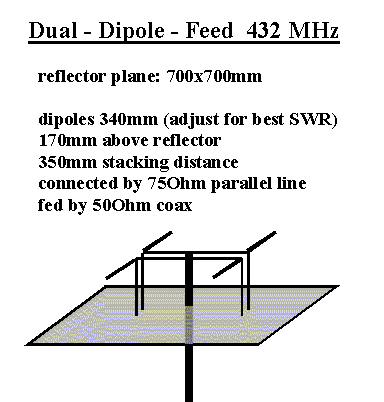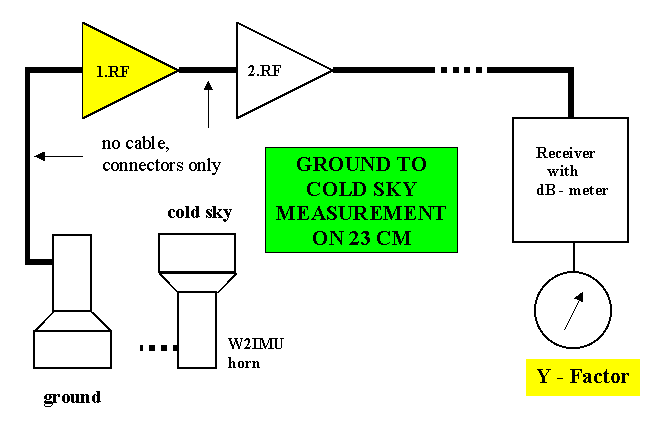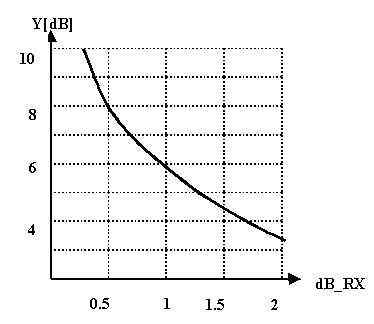 |
 |
Noise Figure Measurement using Standard Antennas
Introduction
Besides using noise figure measurement equipment for adjusting a homebrew receive system there is another and cheaper method to measure the noise figure of preamps for 70cm and 23cm (and up).
The W2IMU horn and the Dual-Dipole-Feed are standard antennas for feeding a dish on 23cm and 70cm respectively. Both have good backlobe suppression.
 |
 |
The method is to measure the ratio of noise output, when turning the test antenna from the warm earth to the cold sky. This ratio is called Y-factor. Because the equivalent cold sky temperature is far below 100K (23:10K 70:45K) and the warm earth provides something like 290K the Y-factor measurement will have considerable magnitude. When applied properly this method can provide very accurate results. The accuracy is in the same order as achieved with professional noise figure measurement instruments. If the ENR-uncernity of noise sources is taken into account the homemade method may be even more accurate.

Theory
The Y-factor-ratio of noise output at the RX is defined as: Y=(Tag+Trx)/(Tac+Trx) [1]
Tag: noise temperature of horn looking to earth; Tac: noise temperature of horn looking to cold sky; Trx: noise temp. of RX
It follows: Y*(Tac+Trx)=Tag+Trx --> Trx*(Y-1)=Tag-Y*Tac and finally: Trx=(Tag-Y*Tac)/(Y-1) [2]
Measurements
With my program ANTTEMP.EXE we can find the equivalent noise temperature by integrating the power pattern of the test antenna weighted with the temperature of cold sky and ambient temperature Ta of 273K at the day of measurement. Pattern integration by ANTTEMP results in the following values when using a W2IMU horn on 23cm: Tag=Ta-5K=273-5=268K;Tac=10K The corresponding values when using the Dual-Dipole-Feed on 70cm are: Tag=Ta-15K=273-15=258K;Tac=45K (higher average skynoise on 70cm)
Other test antennas with different patterns neither exhibit the same equivalent temperatures as given above nor they are suited for this application as well as the feeds above! In any case other antennas have to be calculated first, to determine the equivalent noise temperature.
There is no chance to use the same method for 144MHz preamps, because the noise temperature of the sky on this frequency is in the range of ground noise.
 70cm Preamp with Dual-Dipole-Feed |
 23cm Preamp with W2IMU-Feedhorn |
Results
See Table 1 for 23cm and Table 2 for 70cm. On 23cm the output noise level of cold sky eas about 11dB above the transverter noise. This implies a correction figure of 0.35 dB for the Y-factor as the noise contribution by the second stage, cable and converter are not negligible.
With the higher gain of the 70cm preamps tested and lower loss of the cable this correction is 0.15 dB only (15 dB noise increase).
Table 1: Ground to cold sky measurement with W2IMU horn on 23cm
| 1st preamp | 2nd preamp | Y [dB] | Ycorr[dB] | Y | Trx | NF[dB] |
| JFL1 | JFL2 | 8.75 | 9.1 | 8.1 | 26 | 0.38 |
| JFL2 | JFL1 | 8.25 | 8.6 | 7.2 | 31 | 0.45 |
| 9BV | JFL1 | 8.75 | 9.1 | 8.1 | 26 | 0.38 |
| 9BV | JFL2 | 8.5 | 8.85 | 7.7 | 29 | 0.41 |
| JFL1+relay | JFL2 | 8.25 | 8.6 | 7.2 | 31 | 0.45 |
Table 2: Ground to cold sky measurement with Dual-Dipole-Feed on 70cm
| 1st preamp | 2nd preamp | Y [dB] | Ycorr[dB] | Y | Trx | NF[dB] |
| JFL1_70 | JFL2_70 | 6.0 | 6.15 | 4.1 | 24 | 0.33 |
The resolution of the Y-factor readings were 0.25 dB. All preamps investigated were equipped with a FHX35LG HEMT. The 23cm preamp 9BV served as a reference preamp. It has been measured on a HP8970B noise figure meter with a HP346A noise head to have a 0.37 dB noise figure. This is quite a good agreement between two entirely different methods.
To save some tedious calculation work two graphs (see above) provide a direct facility to conclude your noise figure from your readings in Cold_sky to Ground measurements. If your readings are greater than 8 dB on 23cm and greater than 5.5 dB on 70cm you have a noise figure of roughly 0.5 dB which is state of the art.
Conclusion
Ground to Cold_sky measurements can tell you the truth about your system noise figure.
Some hints to avoid errors when measuring Y-factors should be given:
The sun should be at an elevation lower than 20 deg, otherwise you pick up sunnoise and will get a too high Tac.
Trees and buildings within the mainlobe of the test antenna also raise Tac and lead to a lower Y-factor. If the antenna is turned +/-10deg from zenith and if there is no change in the noise output you eventually measure the true cold sky temperature.
To minimize the influence of ground reflections, make Tag measurements from a spot some meters above ground.